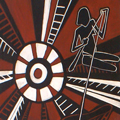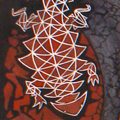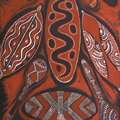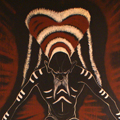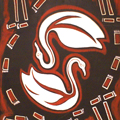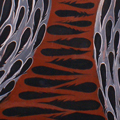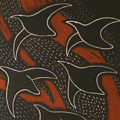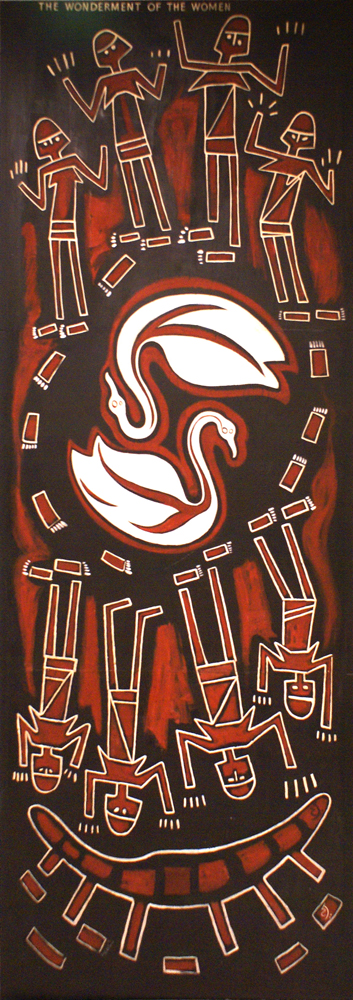The Legend of the Black Swan depicted on ten large panels in 1956, was the fourth in a series directly inspired by Aboriginal art and legend. The story itself was recounted by the Euahlayi people of New South Wales to K. Langloh Parker towards the end of the 19th century and first published as Australian Legendary Tales in London in 1896, republished by Angus & Robertson, Sydney, in 1953. The Durack panels were originally displayed on pillars within the staff dining room of the Sir Charles Gairdner Hospital, Perth and later transferred to walls near the main reception area of the hospital where they can be seen today.
In style and essence The Legend of the Black Swan follows the series: The Cord to Altcheringa (1953), Chant for Kurdaitcha (1954) and Love Magic (1954).
Here again Elizabeth Durack has created works, striking in drama and design, that combine an essence of Aboriginality within her own distinctive style. As with the earlier works, The Legend of the Black Swan panels are an artistic embodiment of two worlds.
*
A summary of The Legend of the Black Swan follows:
This Australian legend has many parallels, with variations, around the world. It tells the story of how white water birds with grey beaks were transformed into black swans with red beaks. It is a story that has been told and retold over many generations and, in the retelling, it varies slightly each time.
The visual depictions of The Legend of the Black Swan highlight some of the more dramatic parts of a story that starts out in —
1 The Land in the West
The Land in the West was a large dry plain inhabited only by powerful women. Night and darkness, fire and death, men and animals did not exist in this land. The women of the west spent their time spinning human hair and making beautiful strong weapons.
2 The Dry Country
One day, Wurrunna, the leader of a tribe from a land in the east, visited the women who lived in the west. To get there he had to cross a dry plain that sustained only small mingari (lizards).
3 The Bartered Weapons
Wurrunna gave the women a possum rug and in exchange they gave him some of their weapons and said: ‘Go, bring us more rugs and we will give you more weapons.’
4 The Transformation
When Wurrunna returned to his people they were delighted with the weapons and were keen to obtain more. Wurrunna, however, suspected the women were spirits and warned his men to be careful. He then planned a way to distract the women. As there were no birds or animals in the land in the west he decided to turn two of his brothers into white water birds, or swans, promising to return them to human beings once his people had achieved their goal.
5 The Wonderment of the Women
Wurrunna’s followers travelled swiftly and quietly. They carried with them possum rugs, a variety of animals and also fire, ready to smoke themselves should danger arise. The women were wary when they saw men, fire and smoke approaching but Wurrunna was keeping an eye on what was happening and he suddenly released his bird brothers on to the plain. The pure white birds so enchanted the women they forgot all about the men. As the women surrounded the birds the male intruders came in closer, dropped their possum rugs, released all their animals and grabbed a great many weapons. Confusion followed ...
6 The Birds Deserted
The men, laden with weapons, managed to escape through smoke from the angry women. Meanwhile, Wurrunna himself travelled on alone towards a sacred mountain. He was intent on meeting Baiame, the great creator. He forgot all about his brothers although they flew after him, crying ‘Biboh! Biboh!’ to attract his attention that he might change them back to men. After some time the birds despaired and tired of flying. They settled on a small lake at the foot of the mountain Wurrunna was climbing.
7 The Attack of the Eaglehawks
The eaglehawks, as messengers and guardians of the spirits of the mountain, were enraged to see two strange birds on their lake. They swooped down upon them driving huge claws and sharp beaks into the white birds. Then they clutched up the bird brothers and flew with them far away to country in the south. Every now and then the eaglehawks stopped and savagely plucked out a handful of white feathers. Eventually they dropped the white swans and returned to their sacred mountain.
8 The Rain of Feathers
The poor brothers, far from home, crouched together, almost featherless, bleeding, cold and miserable. They felt they were dying. Suddenly, softly fell on them a shower of feathers, which covered their shivering bodies.
9 The Flight of Crows
Gaining warmth, the bird brothers looked about them. High on the trees overhead they saw hundreds of mountain crows. The crows called to them: ‘The eaglehawks are our enemies. We saw you left by them to die. We said it should not be so. We are sending some of our feathers to warm you and make you strong to fly back to your country ...’
10 The New Plumage
The black feathers from the crows entirely covered the bodies of the swans apart from their wings where a few white ones remained. Also the down under the black feathers was white down. The red blood on their beaks stayed there forever.
The swans now were able to return to their country. Again they cried out to Warrunna: ‘Biboh! Biboh!’ but though Warrunna heard them this time, he had no power to change his brothers back to men. This power had been taken from him for daring to go, before his time, to Baiame’s sky camp.
*
Story condensed from: ‘The Black Swans’ in Australian Legendary Tales collected by K Langloh Parker, selected and edited by H Drake-Brockman, illustrated by Elizabeth Durack, Angus and Robertson, Sydney and London, 1953.
